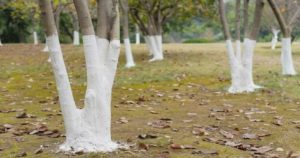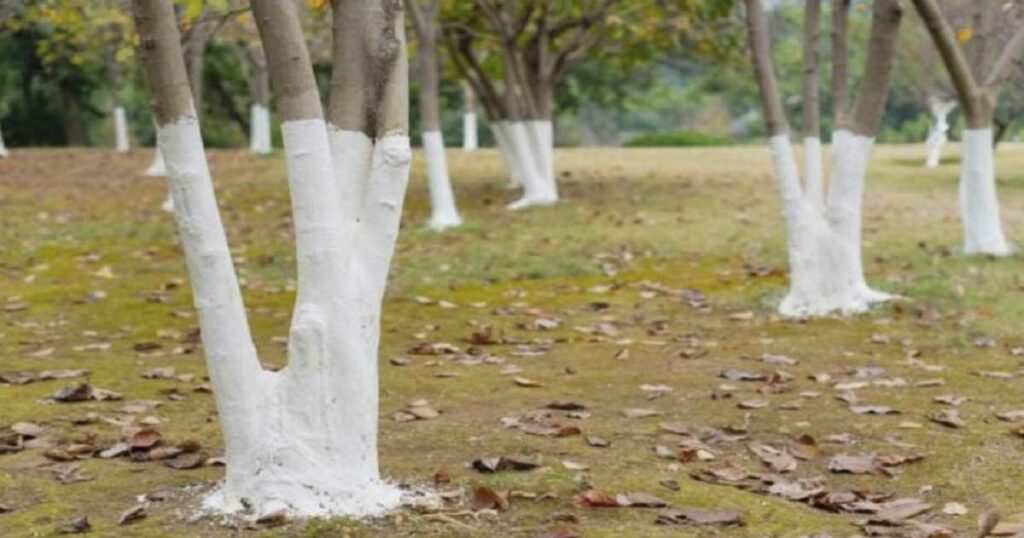The canvas that is nature undergoes a transformation of colours with each passing season, resulting in a spectacular spectacle that elicits feelings of delight and excitement. A creation that is constantly evolving, the splendour of nature can be seen in everything from delicate pink blossoms to leaves with golden hues. In the midst of this colourful exhibition, there are trees with trunks that are painted in a startling white colour, which defies naturally occurring order. It is not a whimsy option but rather a precautionary action that is taken for a number of different reasons.
When tree trunks are painted white, one of the key reasons for doing so is to protect them from sunscald, which is similar to sunburn in plants. The cambium layers are damaged by sunscald, which ultimately results in dehydration. The white colour serves as a natural sunscreen, preventing the tree from breaking and protecting it from any potential damage that could take place. This preventative action is especially important during the winter months, when the bark can be damaged by the varying temperatures that occur during the season, which can range from freezing nights to bright days.
Christopher Evans, an extension forestry and research specialist at the University of Illinois Urbana-Champaign, explains, “Painting the trunks white is said to moderate the daytime heating of the bark and lessen the chances of sunscald injury, especially on thin-barked residential trees or orchards.”
Not only does the white coat protect trees from the influences of the surrounding environment, but it also functions as a discreet marking for a variety of purposes. According to Ken Fisher, an assistant forester for the Boulder Parks and Recreation Department, painting tree trunks white will make them more visible, especially when they are in close proximity to highways. This will help prevent accidents that could have occurred otherwise because drivers will be aware of the existence of trees.

Fisher continues by saying, “In essence, it marks the tree in a way that is not noticeable.” In spite of the fact that a great number of people don’t even see it, it serves to notify our contractor that this is the tree that we are referring to. Due to the fact that we have been utilising paint dots for around 25 years now, there are certain trees that have multiple paint dots on them.
Additionally, in the field of forestry, painted trunks are something that can be used to indicate the status of trees. The trees in the forest are marked to indicate whether they are dangerous or safe, as well as to demarcate the limits of private property. An additional application of this technology is in the field of conservation, specifically in the labelling of trees with nests of endangered or rare species. As an illustration, the nests of the red-cockaded woodpecker, which is classified as a federally endangered species, are frequently marked with a white paint ring in the southern United States.
Nevertheless, as is the case with any visual language, there is a lack of standardised symbols and colours, which means that there is the possibility for confusion. The presence of an X on a tree may signal that it should be cut down, whereas the presence of numbers may suggest a count prior to a harvest.
If you are thinking about painting trees, you should know that there is an art to it. Because oil-based paint can impede the tree’s ability to breathe, it is essential to steer clear of using said paint. The most recommended option is latex paint that is water-based and has been adequately diluted. It is advisable to apply a one-gallon latex with four or five quarts of water, ideally with an organic foundation, in order to abstain from using additives that could potentially cause harm to the plants. It is possible to apply the colour with a straightforward paintbrush, and although white is the most popular colour, various light colours are good alternative colours. In areas that experience severe weather, it is recommended that paint be reapplied once a year in order to maintain its protective qualities.
It is a subtle blend of science, conservation, and pragmatism, maintaining the well-being of nature and expressing messages in a language that is understood by both arborists and casual spectators alike. In essence, the technique of painting tree trunks goes beyond only being an artistic endeavour.


